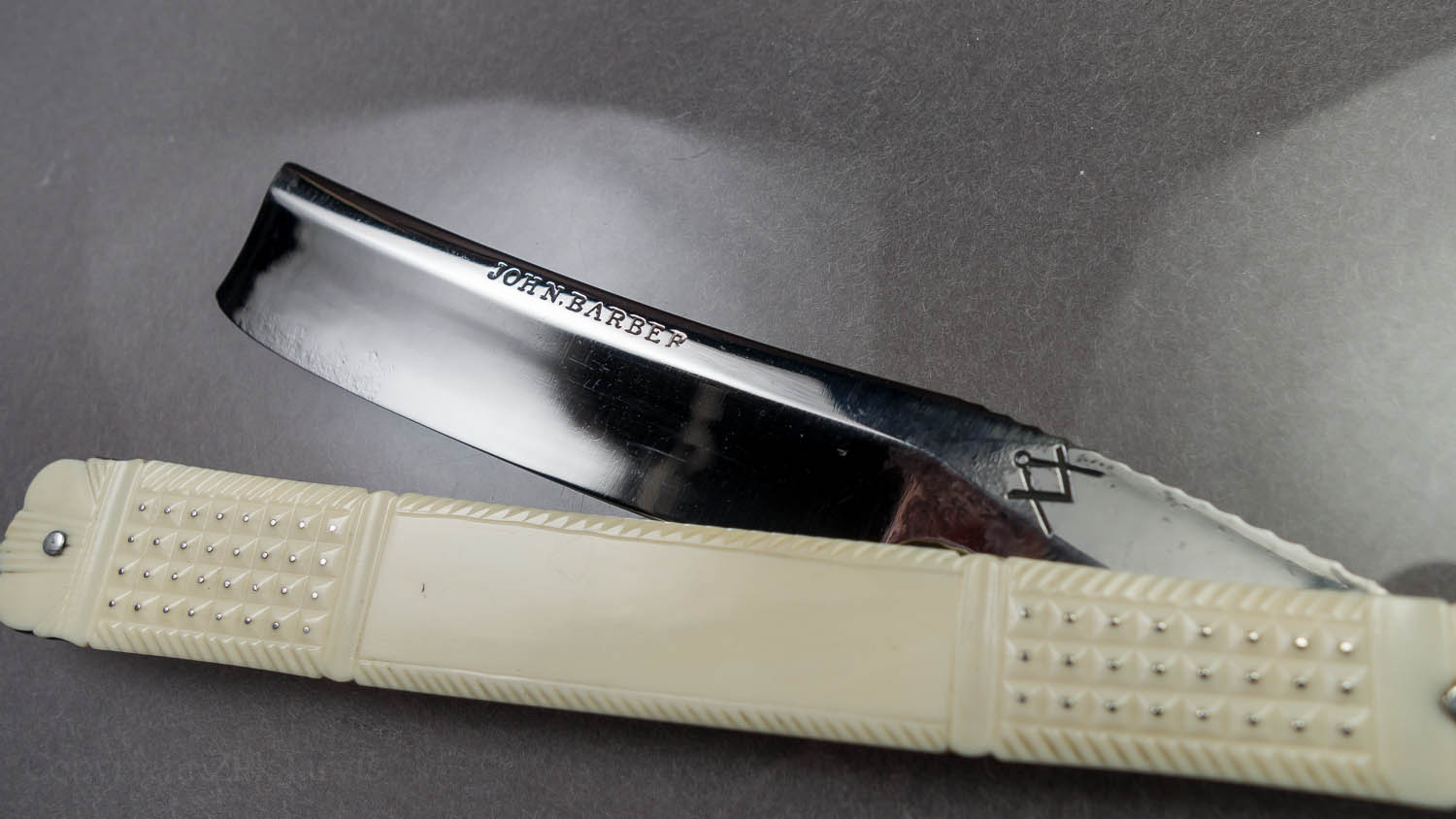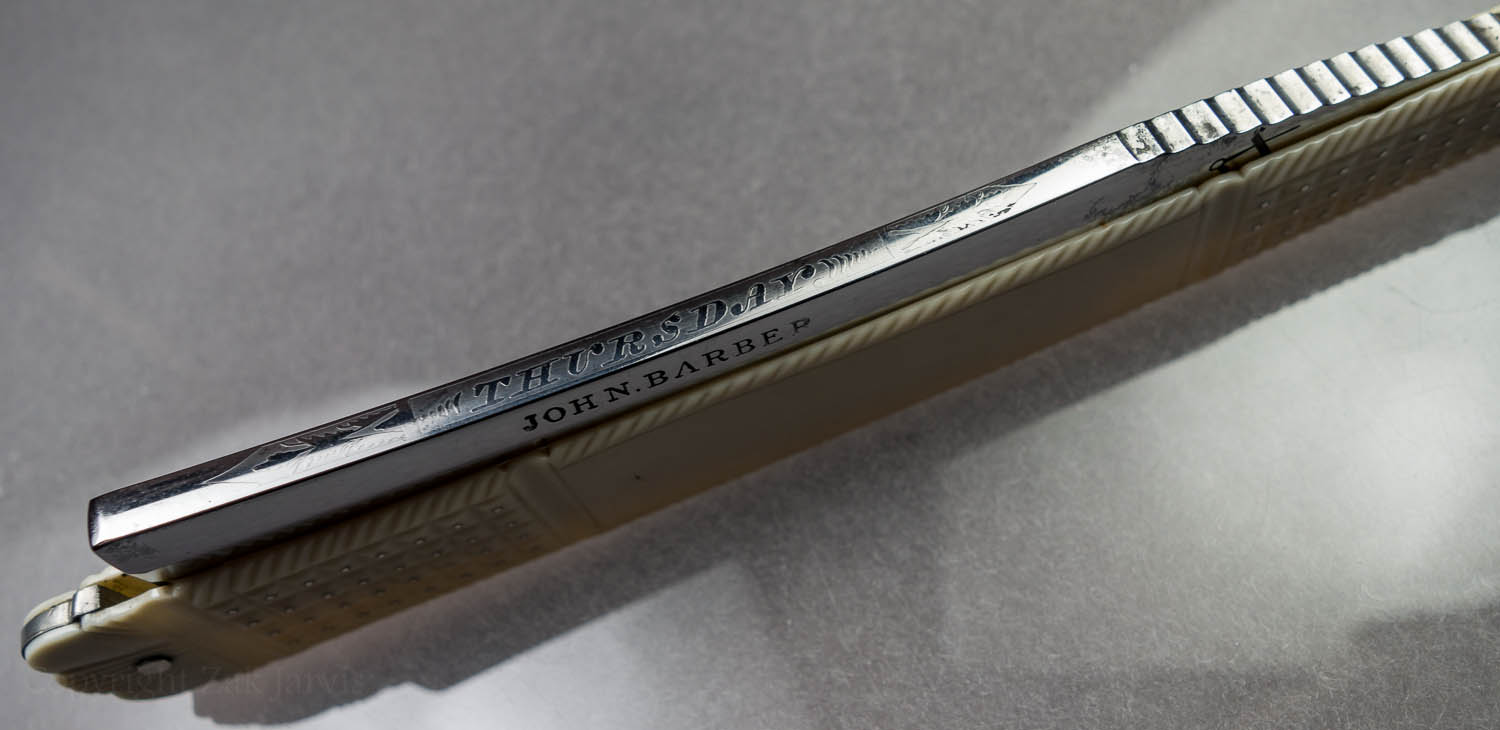Results 1 to 10 of 32
Thread: John Barber pair in piqued ivory
Hybrid View
-
06-02-2014, 06:56 AM #1

I went back and scrutinized the pics of yours and also the one Hoglahoo has in the SRP Wiki, and I think these four are all from the same set.
They've all got the same weird die irregularity on the 'JOHN BARBER' part. It's 'JOH N.BARBER', complete with extraneous punctuation, on all four, which tells me it was a damaged die that they were stamped with.
So, Hoglahoo... What day is yours?-Zak Jarvis. Writer. Artist. Bon vivant.
-
06-02-2014, 01:38 PM #2The First Cut is the Deepest!


- Join Date
- Feb 2010
- Location
- Upper Middle Slobovia NY
- Posts
- 2,736
Thanked: 480
If you find the whole set, you guys should arrange a reunion gather!
-
06-09-2014, 06:52 AM #3

I did a partial restoration on the one I got, including a very light regrind to remove a previous very light regrind. (Thank you 10Pups!)



Heh. I'm so used to not polishing the jimps1 out that I left a bit of crud there. Oh well! Easy to fix.
- Traditionally the jimps were rarely ever polished, probably because most razors were polished on a lead lapping wheel and polishing the jimps would rake big grooves in the surface.
-Zak Jarvis. Writer. Artist. Bon vivant.
-
06-09-2014, 07:48 AM #4

Splendide restoration !

-
The Following User Says Thank You to Thaeris For This Useful Post:
Voidmonster (06-09-2014)
-
06-09-2014, 02:22 PM #5Senior Member



- Join Date
- Apr 2008
- Location
- Essex, UK
- Posts
- 3,816
Thanked: 3164
Smaller parts, such as the tang and jimps, were often polished using small diameter wheels and wheels that were very thin. Longer flat surfaces were often dressed using plain hardwood wheels with 'deadened' (ie well used or pulverised) 'crocus' (hard iron oxide that accumulated against the bottom and sides of the baking pots - the softer type in the middle was sold to colourmen and jewellers) mixed with suet and beeswax, and small serrated surfaces like jimps were polished (mostly on the top) with a small wooden wheel dressed with very thick leather - this got into all the crevices, unlike the lead-lapped wheel which would be injured if brought up against a serrated surface.
Traditionally, walrus leather was used. It was/is so thick, that it was ideally suited for buffing wheels. Back in the day seal hide was substituted for walrus as it had the same sort of thickness and 'give' to it.
As more of a 'glaze' finish was required, the speed of the buffing wheel would go up from2,500 sfpm to over 7,000 sfpm and the wheel would change from soft walrus hide, to hard leather and then to plain hardwood.
Regards,
Neil
The terms used were 'black polishing' for the main part of the blade and 'glazing' for the shanks, tail, etc.
The work was carried out by women and small boys usually.
-
The Following 4 Users Say Thank You to Neil Miller For This Useful Post:
JimmyHAD (06-09-2014), Noswad (06-11-2014), Voidmonster (06-09-2014), Wolfpack34 (06-09-2014)
-
06-09-2014, 03:31 PM #6

Great job on the Barber Zak! It really came out nice. Can't wait to see it!
Lupus Cohors - Appellant Mors !
-
The Following User Says Thank You to Wolfpack34 For This Useful Post:
Voidmonster (06-09-2014)
-
06-09-2014, 03:40 PM #7

Great post Neil! I've been experimenting with a 'soft' satin look using 800 grit Crocus cloth and I really like the way the finish looks. I wonder if a hard wheel (maybe Sisal?) that has been pasted or 'rubbed with' lead... similar to a lead pasted strop... would work like a lead lapping plate? I think I might give it a try to see what happens...

Lupus Cohors - Appellant Mors !
-
06-09-2014, 03:44 PM #8
-
06-11-2014, 10:18 PM #9Senior Member

- Join Date
- Feb 2014
- Posts
- 225
Thanked: 36
beautiful scales!
-
06-11-2014, 10:48 PM #10Senior Member




- Join Date
- Nov 2012
- Location
- Across the street from Mickey Mouse in Calif.
- Posts
- 5,320
Thanked: 1184
I have had the pleasure of holding this razor and it looks better live that's for sure. Not that your photography is bad Zak :<0).... I have to admit I closed my eyes and held my hands over my ears when he tightened the pivot pin. My pin anvil is very sturdy but still ....
Good judgment comes from experience, and experience....well that comes from poor judgment.


 61Likes
61Likes LinkBack URL
LinkBack URL About LinkBacks
About LinkBacks








 Reply With Quote
Reply With Quote
